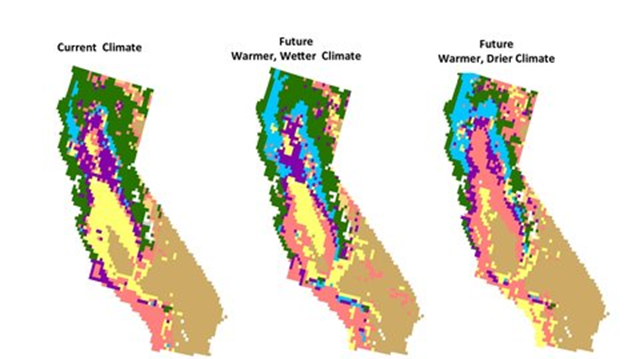California cattle range to decrease as climate changes
By FELICITY BARRINGER
23 January 2012 To see how thoroughly the concept of ecosystem services — the economic analysis of the natural world’s intersection with human endeavors — is embedded in climate change research, check out this forecast from a group led by researchers at Duke University and the Environmental Defense Fund. It examines the future of cattle ranching, an industry that is bound up with America’s self-image, thanks to Hollywood, pulp novels and Cormac McCarthy, through the lens of a climate-changed California landscape. It concludes that, whether the state’s climate becomes warmer and wetter or warmer and drier, it will be more expensive to raise cattle because there will be less forage to sustain the animals. Significant amounts of forage — nature’s free “service” to the cattlemen — will either be dessicated (under the warmer and drier projection) as the arid conditions in southeastern California inch northward or will be replaced by less-digestible scrub and brush (under the warmer and wetter projection), the study projects. The loss will cost California ranchers tens of millions of dollars annually if it is warmer and wetter over the next 60 years or so, and $123 million to $209 million a year if it is warmer and drier, the article suggests. In coming decades, “there will be fewer places to graze cattle and cattle grazing lands will be less productive,” said Linwood Pendleton, one of the study’s lead authors, an ecosystems services specialist at Duke’s Nicholas School of the Environment. “And because we’ve built up cities and highways around them, there’s nowhere to move to.” Rebecca Shaw of the Environmental Defense Fund agrees. “If you look at the way climate is going to change the distribution of ecosystems in California, we are likely to see a decrease in grasslands and range lands and an increase in woody biomass and shrubs” — in the warmer and wetter projection — or a spread of arid landscapes where little grows, under the warmer and drier projection, she said. Shrubland, while biodiverse, does not provide good cattle forage, Dr. Shaw said, “so shrublands grow at the expense of grasslands.” […] The findings of the new report, published in the journal Climatic Change, can be extrapolated well beyond California’s boundaries, to Plains states like Texas, Oklahoma, and Nebraska, where cattle are a bigger slice of the agricultural economy, Dr. Pendleton said. “It is the grass-fed beef that everyone’s telling us we should be eating that is going to take a hit,” he said, adding that in most cases, “you will just have fewer cows on the same land.” One variable that could upend some of the study’s projections is the number and intensity of wildfires in a climate-changed California. Dr. Shaw said that the bigger and hotter a fire, the more likely it would consume the woody scrub growth and give grasses a chance to regrow. […]
